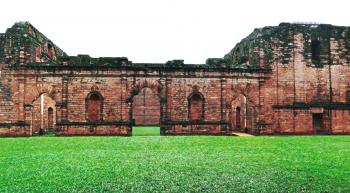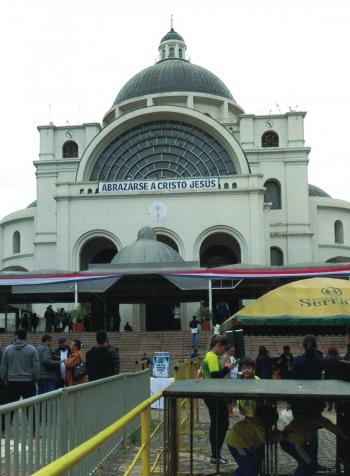Delving into Paraguay’s Jesuit history with a private tour of the missions of the south
This article appears on page 16 of the August 2020 issue.
After having visited all of the countries of South America except Paraguay and Venezuela, when I decided to pay another visit to the continent, it was an easy decision to choose Paraguay. With a US State Department travel rating of Level 1 (Exercise Normal Precautions), Paraguay obviously beat out Venezuela’s Level 4 “Do Not Travel” advisory.
I could not find any group tours that just visited Paraguay, so I contacted Adrian Chalker at Adventures Abroad (800/665-3998, adventures-abroad.com) to arrange a private tour. They worked with a local agent, Vanessa Torres, General Manager of Discover South America. My trip cost $3,900, including hotels, many lunches, a driver and a guide.
One of my main interests was to visit the Jesuit missions located in southern Paraguay. Some are now UNESCO World Heritage Sites.
In and around Asunción
My journey began on May 26, 2019, with a Copa Airlines flight from Los Angeles to Asunción, Paraguay, via Panama City, Panama.
A visa is required to enter the country, and for US citizens it can be obtained at the airport on arrival. (Before you approach Immigration, there is a booth with a “visa arrival” sign.) The cost is $160, payable in new, unmarked, crisp US bills.
I was photographed and fingerprinted, then the officer placed the visa in my passport. Just a few steps away was the Immigration checkpoint, then Customs, and then I was on my way to my waiting guide and driver.
Because I had arrived in Asunción, the capital city of Paraguay, at around 4 a.m., the tour company had booked a hotel room for me for the night before so I could immediately check in and get some much-needed rest before the start of my scheduled afternoon city tour.
I selected the hotels on this private tour; in Asunción, I stayed at the Sheraton Asunción (Aviadores del Chaco 2066), a full-service, centrally located hotel that proved to be an excellent choice.
My local guide, Alban Ehler, and a driver met me at 2 p.m. for some afternoon city sightseeing. The city tour included a stop at the Government Palace, built around the late 1800s, overlooking the Paraguay River. Some of the city’s earliest buildings can be found along the street that fronts the palace; today, it is a beautiful pedestrian area.
On our walking tour of the central area of Asunción, Alban pointed out the many murals painted on building walls, the result of a program for artists to show off their work that was sponsored by the government several years before.
A museum that was on my list to visit was Museo del Barro, which houses a collection of local art and crafts in a very modern building. It was a small but excellent collection!
The next day was a full day of sightseeing along the Golden Circuit, a circle of historic towns around Asunción. Our route included stops at the beautiful Franciscan church of Yaguarón, the Paraguarí Hills viewpoint, overlooking the surrounding area, and the historic city of Piribebuy, where we visited the beautiful Caacupé Basilica, containing the Virgin of Caacupé — widely worshiped by Paraguayans.
Along the shore of Lake Ypacaraí in San Bernardino, we stopped for a delicious schnitzel lunch (included) at Hotel del Lago. After lunch, I toured the historic hotel, built in 1888 in the European style.
It features dark wood paneling and is filled with antique furniture and photographs, but it also has a connection to San Bernardino’s dark past, as it is said to have been a place of shelter for former Nazi officers and supporters after World War II.
Mission visits
After two days of sightseeing in Asunción, I departed for Encarnación and the Jesuit missions that were the main focus of my trip.
The Jesuits arrived in Paraguay in the early 17th century and were expelled in the mid 1700s. It was during that period that they built the missions, gathering the local Guaraní people into communities.
My first stop was the Jesús de Tavarangue Ruins, declared a UNESCO Site in 1993. Its main church was in the process of being built when the Jesuits were expelled, and only the walls remain; its roof was never built. Still, the carvings and stone detail are in very good condition, even after being exposed to the elements over so many years.
La Santísima Trinidad del Paraná ruins was declared a UNESCO Site the same year. The largest of all the Jesuit missions in this area, it is also the best preserved. I walked around the grass field to admire the remains of the red-brick structures that once housed between 2,000 and 3,000 Guaraní people.
We also visited the museum of Santa María de Fe, which has a large collection of Guaraní woodcarvings and statues that were originally in the mission. The pieces were beautiful.
Culture through cuisine
By late afternoon, I was ready to check into my hotel for the next two nights, the AWA Resort Hotel (Ruta 1 km 367, Tajy y Naranjal) in Encarnación. This was a lovely resort away from the main town and overlooking the river.
Paraguay is noted for its wonderful beef, and my dinner on the second evening at the resort was beef medallions. The waiter spoke little English and my Spanish is very limited, so he used a Google app to translate how I wanted my steak cooked. It was perfect! (My bill for two dinners during my stay, including dessert and wine, was $62.)
While in Encarnación, we briefly visited the nearby San Cosme y Damián mission. Its priest, Buenaventura Suárez, was a scientist, physicist and astronomer, and the mission was an important astronomical center. Today, its astronomy building offers a short presentation on the southern skies.
After departing Encarnación, we headed to Itauguá, known as the “City of Ñandutí,” the “spiderweb” lace made by the local women. Threads are drawn through fabric, and when the design is complete, the fabric is cut away. Although I am not a shopper, I couldn’t resist purchasing one of the delicate pieces to take home.
Paraguay’s national drink is made from yerba maté, and my guide wanted me to see how it was processed, so we stopped at the Selecta yerba maté factory in Bella Vista for a tour. The leaves of the yerba maté plant are picked, dried and packed into tea bags ready for shipment all over the world.
Our lunch breaks on this trip were at local grocery stores with cafés attached, and all were very clean, including the restrooms. My guide introduced me to empanadas, an inexpensive pastry filled with chicken, cheese, ham or beef and either baked in the oven or fried. I tried a different one each day, and I thought the oven-baked ones were the best.
Another local food I had was sopa paraguaya, cornbread with onion and cheese served in small squares. Very tasty!
My last full day in Paraguay featured an all-day excursion to Ybycuí National Park. On the way, we stopped in Itá to visit the workshop of artist/potter Fermina Benitez, who has been creating gallinita de la suerte, clay chickens thought to bring good luck, for decades. Everyone buys one, and so did I.
At Ybycuí National Park, a large area with walking trails through forests, creeks and crystal-clear waterfalls, my guide and driver prepared a picnic lunch of grilled hamburgers for us.
I really enjoyed this short trip to southern Paraguay. Many of the people there do not speak English, which can be a disadvantage if you don’t speak Spanish and are traveling alone, but with an excellent guide, it was no problem for me.
Add this interesting country to your bucket list. You will not be disappointed!




